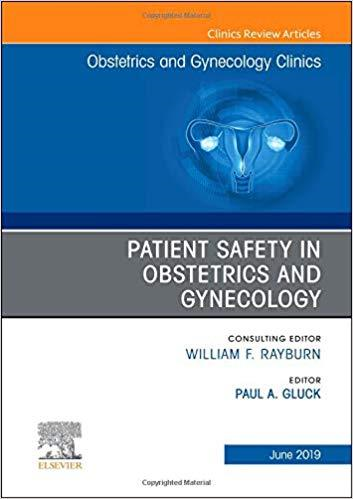Description
In collaboration with Consulting Editor, Dr. William Rayburn, Dr. Paul Gluck has put together a state-of the-art
issue of the Obstetrics and Gynecology Clinics of North America devoted to Patient Safety in Obstetrics and Gynecology.
Clinical review articles from expert authors are specifically devoted to the following topics: The Patient Experience
and Safety; The Certification Process Driving Patient Safety; Just Culture and Patient Safety; Patient’s Role in
Patient Safety; Implementing Patient Safety Initiatives; Eliminating Disparities In Perinatal Care;
Transparency and Disclosure; Leadership and Teams; Emerging Role of Drills and Simulations in Patient Safety;
California Maternal Quality Care Collaborative: The Power of Collaboration; Role of the Patient Safety Organization in
Advancing Patient Safety; Office of Patient Safety; Applying Patient Safety to Reduce Maternal Mortality; Benefits and
Pitfalls of Ultrasound in Ob/Gyns; Obstetrical Anesthesia; Patient Safety in Outpatient Procedures; and Safety in
Minimally Invasive Surgery. Readers will come away with the latest information they need to improve outcomes and
safety in obstetric and gynecologic patients.
Forthcoming Issues
Foreword
Preface
Focus on the Patient
The Patient Experience and Safety
Key points
History
Patient centeredness
Medical community resistance
The safety data
The future of the patient experience
Summary
The Patient’s Role in Patient Safety
Key points
Medical errors
The patient-family contribution
Case scenario: speaking up
더보기
Patient and clinician considerations in patient safety
Case scenario: communication and clarity
Basic recommendations for partnering with patients
Special issues in patient safety
Tools for clinicians
The Teach Back Method
An innovative community resource
Family-centered patient advocate training
Patient Activation through Community Conversations
A.S.K. for Your Life campaign: addressing racial bias
Other vulnerable populations
Summary
Quality Improvement Approach to Eliminate Disparities in Perinatal Morbidity and Mortality
Key points
Introduction
Strategy 1: apply a systems approach based on the Socio-Ecological Model
Strategy 2: identify root causes of disparities
Strategy 3: identify and eliminate strong but wrong routines
Strategy 4: use improvement and implementation science methods and tools
Strategy 5: use data to guide the plan and track progress
Summary
Focus on Culture
Patient Safety and the Just Culture
Key points
Introduction
Finding the right language
The severity bias
Throwing out the baby with the bathwater
The Just Culture model
The benefits of a Just Culture
Transparency and Disclosure
Key points
Case study
Widespread acknowledgment of pervasive errors and harm in health care
Regulatory agencies requiring disclosure of adverse events or outcomes
Technology has created a greater expectation of transparency
Rapid increase in health care cost
Foundations of transparency and disclosure in medicine
If you are sorry—apologize!
Early resolution
Summary
Role of Patient Safety Organizations in Improving Patient Safety
Key points
The road ahead in response to changing health care delivery
Implementation and Change Management
The Certification Process Driving Patient Safety
Key points
Introduction
Initial certification
Maintenance of certification
Summary
Implementing Patient Safety Initiatives
Key points
Introduction
Implementing patient safety initiatives
Part 1: the problem with engagement in health care
Part 2: patient safety in a new age
Part 3: implementation—putting it all together
Other considerations that can help build engagement
Summary
Leadership and Teamwork: Essential Roles in Patient Safety
Key points
Introduction
Principles of leadership
Principles of teamwork
Summary
Emerging Role of Drills and Simulations in Patient Safety
Key points
Introduction
Drills and simulations defined
The evolution of medical education toward incorporation of simulation
Improving patient safety through simulation and drills in obstetrics and gynecology
Who?
What?
When and where?
How and how often?
Why?
Summary
Creating Change at Scale: Quality Improvement Strategies used by the California Maternal Quality Care Collaborative
Key points
Principle 1: engage as many partners as possible: collective impact is powerful
Principle 2: maternal data center to inform and manage quality improvement
Principle 3: tool kits: guidance on best practices
Principle 4: implementation guidance for successful engagement and improvement
Summary
Obstetric Anesthesia: Leading the Way in Patient Safety
Key points
Safer and more effective labor analgesia
Safer treatments for hypotension associated with neuraxial blockade
Advances in spinal and epidural techniques for operative deliveries
Decreasing the incidence of postdural puncture headache through improved technology
Safer parental agents for labor analgesia
Improved safety of general anesthesia in obstetrics
Improved education and the use of simulation including team training
Reduction of operating room–related infections
Future directions
Emerging Clinical Trends
Office Patient Safety
Key points
Introduction
Human factors and clinical practice
Sources of error in clinical practice
Strategies to support and improve patient safety in office practice
Summary
Applying Patient Safety to Reduce Maternal Mortality
Key points
Introduction
Early warning alert systems and triggers
Bundles
Standardization of practice
Implementation of new programs and practices
Health information technology and patient safety
Racial and ethnic disparities in maternal morbidity and mortality
Summary
Benefits and Pitfalls of Ultrasound in Obstetrics and Gynecology
Key points
Introduction
Obstetric ultrasound evaluation
Gynecologic ultrasound evaluation
Summary
Patient Safety in Outpatient Procedures
Key points
Introduction
Sea-change in the site of service
Reasons for the outpatient surgery shift
Patient safety/outcomes
Ambulatory Surgery Center explosion
Rise of accreditation organizations
Origin of standards
The office setting
Evolution of the Outpatient Safety Assessment and the Safety Certification in Outpatient Excellence
Future trends for outpatient surgery
Summary
Safety in Minimally Invasive Surgery
Key points
Introduction
Procedure selection: should a laparoscopic approach be offered?
Patient optimization
Patient positioning: why is this important?
Laparoscopic entry: what’s the big deal about gaining peritoneal access?
Summary


